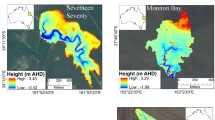Abstracts
Gases in the marine boundary layer in Fildes Peninsula, maritime Antarctica were sampled and analyzed for the first time. Sampling sites included areas covered by moss and lichen growth, penguin colonies and an area where scientific research stations are located. A total of 211 samples were analyzed for N2O concentrations, with an average of (321.33±3.07) nL/L. This is above the global average value of 314 nL/L. It is found that the N2O concentrations evidently increase during the summer months. Concentrations around the research stations are higher than at remote areas, indicating a potential source from human activities on the island. N2O concentrations at a large penguin colony on Barton Peninsula are the highest among the sampled areas. This may explain why N2O concentrations in Fildes Peninsula are higher than the global average. Our preliminary conclusions are that human activities and emissions from penguin dropping-amended soil and vegetation soil constitute the major sources of N2O in the maritime Antarctic atmosphere.
Similar content being viewed by others
References
Crutzen, P. J., The influence of nitrogen oxides on atmospheric ozone content, Quarterly Journal of Royal Meteorological Society, 1970, 96: 320.
Fluckiger, J., Dallenbnch, A., Blunier, T. et al., Variations in atmospheric N2O concentration during abrupt climatic changes, Science, 1999, 285: 227.
Bouwman, A. F., Soil and the Greenhouse Effect, Chichester: John Wiley and Sons, 1990, 61–128.
Granli, T., Bockman, B. C., Nitrous oxide from agriculture, Norwegian, J. Agric. Sci., 1994(suppl.12): 7.
Xing, G. X., N2O emission from cropland in China, Nutrient Cycle in Agroecosystems, 1998, 52: 249.
Xing, G. X., Zhu, Z. L., Preliminary studies on N2O emission fluxes from upland soil and paddy soils in China, Nutrient Cycling in Agrocosystems, 1997, 49: 17.
Xing, G. X., Yan, X. Y., Direct nitrous oxide emission from agricultural fields in China estimated by the revised 1996 IPCC guidelines for national greenhouse gases, Environmental Science and Policy, 1999, 2: 355.
Legrand, M., Ducroz, F., Wagenbach, D. et al., Ammonium in coastal Antarctic aerosol and snow: role of polar ocean and penguin emissions, J. Gephys. Res., 1998, 103: 11043.
Eicher, L. J., Nitrous oxide emissions from fertilized soils: summery of available data, J. Environ. Qual., 1990, 19: 272.
Keller, M., Kaplan, W. A., Wofsy, S. C. et al., Emissions of nitrous oxide from tropical forest soils: response to fertilization with ammonium, nitrate and phosphate, J. Geophys. Res., 1988, 93: 1600.
Paul, J. W., Nitrous and nitric oxide emissions during nitrification and denitrification from manure-amended soil in the laboratory, Can. J. Soil Sci., 1993, 73: 539.
Aulakh, M. S., Doran, J. W., Walters, D. T. et al., Crop residue type and placement effects on denitrification and mineralization, Soil Sci. Soc. Am. J., 1991. 55: 1020.
Lindeboom, H. J., The nitrogen pathway in a penguin rookery, Ecology, 1984, 65: 269.
Author information
Authors and Affiliations
About this article
Cite this article
Sun, L., Xie, Z., Zhao, J. et al. Monitoring the concentration of N2O in the Fildes Peninsula, maritime Antarctica. Chin.Sci.Bull. 45, 2000–2004 (2000). https://doi.org/10.1007/BF02909696
Received:
Issue Date:
DOI: https://doi.org/10.1007/BF02909696




